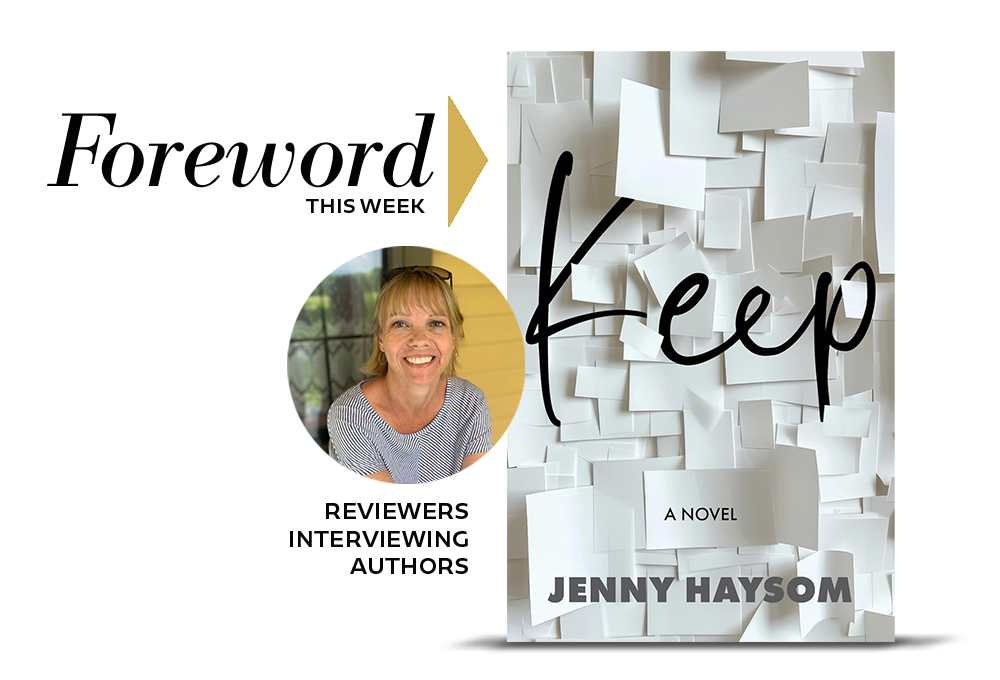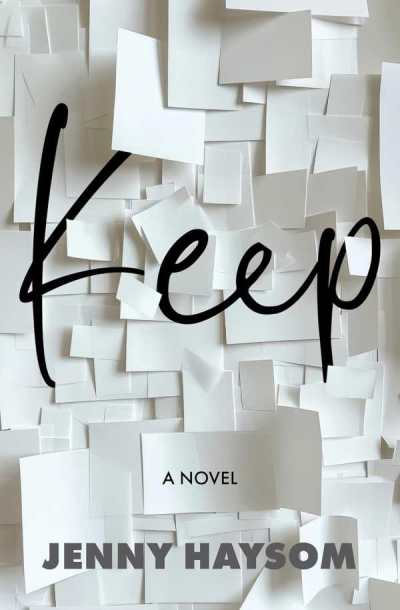Reviewer Rebecca Foster Interviews Jenny Haysom, Author of Keep

“For many Indigenous peoples, certain objects (such as canoes and totem poles) have a spiritual significance, and like actual ancestors’ bodies, must be honoured, left in place to return to earth (rather than gathered and displayed in glass boxes). It’s a beautiful philosophy, perhaps a better way, and I often feel guilty about my own compulsions. Why do I need to have things when I too shall pass away?’’ —Jenny Haysom
In every issue of Foreword Reviews, we discover a gem of a book that crosses genres and appeals on so many levels that we don’t know where to start. Jenny Haysom’s Keep—reviewed by Rebecca Foster—fits that bill in September/October; it’s a literary novel about aging and letting go but it’s set in Ottawa in 2017, which happens to be Canada’s sesquicentennial, a historical note which allows Jenny to reckon with the appalling treatment of the country’s Indigenous population by its European settlers.

In her review, Rebecca says the novel “contrasts hoarding and generosity … raises the moral issue of preservation versus progress [and] … Underneath that is a deeper question of ownership, represented by the graffiti ‘You are all on traditional unceded Algonquin territory.’”
If you’re hankering for a high level literary conversation, stay tuned.
We covered four other works of literary fiction in September/October: The Diapause, Before the Mango Ripens, Eugene Nadelman: A Tale of the 1980s in Verse, and Awake Forever in the Sweet Unrest. Check those out here and then take a minute to register for your free digital subscription.
Harriet’s house is, for various players and at different times, a refuge or a prison. How did you play with the multiple meanings that a house can have?
This is such an interesting question––mostly because I hadn’t envisioned Harriet’s house as anything other than a refuge for her (it may be a cluttered hell for others). The retirement home, on the other hand, certainly has the potential for being a prison (with its automatically locking doors and windows too small to escape from). But you’re so right to point out the paradox––the ways homes can function as one or the other, or both at the same time, and how it all depends on the perceptions of the characters and their particular circumstances. Eleanor certainly fantasizes about escaping her domestic life, and Yves is feeling claustrophobic and confined in his own condo (while Jacob is keen to nest). Even Jacob winds up feeling trapped in a house; specifically, in his parents’ suburban basement. … All this to say I see what you’re getting at.
Now back to Harriet. Because her home is familiar, I think it is primarily enabling, not limiting, especially as she loses her memory (in fact, it helps her remember her poems in the end). Likely, it’s her seclusion itself that has become the problem, because we all need human interactions and connections to stay well. Perhaps that’s what you’re also gesturing at––the way a home makes space for solitude? (Or, to flip the wording and get carceral again, let’s say it permits a type of solitary confinement, which would suggest that the withdrawal isn’t chosen, but imposed.) As a writer, I’m fascinated by this problem, relishing my peace and quiet, but also recognizing that too many hours alone can be warping––dementing even.
A local swimming hole called The Scoop is a site of recurring danger. In some writers’ hands, it might have been a setting in a horror novel. In comparison with the house, and across time, what does the pond represent and is it inescapable?
Again, it’s so interesting that you say this. Someone who read the manuscript in draft told me she was expecting a horror novel at the outset. Honestly, I was a little taken aback, but now wonder if the feelings she had had something to do with a few gothic touches, a sense of the otherworldly on the edge of things. Perhaps this is a ghost story without any actual ghosts?
The Scoop is actually based on a real place. I lived in Ottawa for many years and swam regularly at a public swimming hole in a very privileged neighbourhood. It was fascinating to observe social change over those years, and while I lamented the increasing popularity of the place (it may be getting unsustainable), I also delighted in it––in people asserting their rights and pushing back against snobbery.
Harriet’s house is near the pond, in the same privileged neighbourhood, and the novel certainly explores a variety of related social issues. To be honest, I didn’t want to write a story that was explicitly political, and yet we’re in a very political moment––aren’t we? I’m really hoping that these circumstances are more of a backdrop than anything else, that while Keep is set in a specific time and place, it’s also meaningful beyond those particulars.
Looking back, I’m not sure I fully answered your question, but I’ll wrap up by saying that I think the pond has a dark magnetism for Harriet.
You expand the view in an interesting way by calling attention to the history of this plot of land. How does the graffiti about Indigenous territory complicate the question of property, and set the rest of the story in perspective?
I’m so glad you asked about this. As I mention in my acknowledgments, the story is set in Ottawa in 2017, the year of Canada’s sesquicentennial (the 150th anniversary of Confederation). Naturally, Indigenous groups were protesting the occasion, but there was also a larger shift in the public consciousness then, and it was palpable; many of us––myself included––were finally recognizing all that we had taken from Indigenous peoples, including land.
Rather than being a happy celebration, the actual birthday party was a flop. On the day of the festivities, it poured with rain. It was like a biblical deluge. The heavens opened and drenched everything and everyone. People were dressed in their plastic, red-and-white Dollar Store ponchos and queueing miserably for spots on the marshy, muddy front lawn of Parliament. You couldn’t help but feel that some sort of higher authority was weighing in on the matter.
Back to your question: With the exception of the graffiti, I tried to keep these issues in the background, to stimulate some complicating questions about property and ownership, as you note. For example, in an effort to appeal to buyers, home staging artfully erases personal history … but how can we connect this concept of erasure to the effects of colonization?
Is it ironic that Eleanor and Jacob are in this line of work yet frustrated with or exiled from their own homes? Or is their disillusionment more of a universal experience?
I think it is ironic; Eleanor and Jacob are professional home makers, yet their own home lives are a mess, so to speak. While they have this in common, their particular circumstances are so different. For starters, Jacob craves all the comforts of home and longs to cement his attachment to Yves in rather traditional, domestic ways. Eleanor is further along in the process––and yes, feeling disillusioned. She’s well past the nesting phase and is feeling burdened by motherhood and the prospect of it extending endlessly. While they’re at different stages in life, I think they’re both concerned about the nature of their work; the fakery, the constant consumption––and perhaps even their roles in the larger capitalist machinery. It’s so hard to live these days without feeling guilty or complicit, even when we have good intentions.
Why was it key for Eleanor to be in this transitional (“sandwich”) stage where she’s placed between an elderly client on the one hand and a young adult colleague and adolescent children on the other?
That’s a good point; Eleanor is in a kind of “sandwich” position, though her own mother has died (as well as Lawrence’s). It’s certainly the transitional stage I’m at (my parents are both frail and elderly, and my daughter is a university student who is increasingly independent but still needing support). Honestly, it’s a hard place to be, especially as I’m facing my own health issues and have less physical energy to deal with escalating demands. As for Eleanor, I think she finds this middle space, with all its responsibilities, rather lonely.
I loved the moment when Eleanor’s professor husband sells a beloved first edition so that he can treat her to dinner. It’s a more minor example of a dilemma that faces all the central characters in the book: what to keep and what to jettison. How did this theme come to capture your imagination?
Thank you so much for saying this. It does my heart good. Lawrence really surprised me when he did that––it happened in a later draft, and I was pleased with him.
The problem of what to keep and what to jettison is one of the ongoing struggles of my life, and perhaps this novel is a dramatization of those struggles, my inner Eleanor and Harriet duking it out. That said, while I constantly aspire to Eleanor’s brisk minimalism, I usually err on the side of chaos and accumulation. Like Harriet, I’m a collector by nature, and that behaviour is fraught with all kinds of problems, personal and political.
To explain what I mean by this: Collecting is very much a Western activity, one that’s both artistic and scientific; it’s the impulse behind institutions like museums. Interestingly, it’s also antithetical to some cultural practices. For example, for many Indigenous peoples, certain objects (such as canoes and totem poles) have a spiritual significance, and like actual ancestors’ bodies, must be honoured, left in place to return to earth (rather than gathered and displayed in glass boxes). It’s a beautiful philosophy, perhaps a better way, and I often feel guilty about my own compulsions. Why do I need to have things when I too shall pass away?
Rebecca Foster
